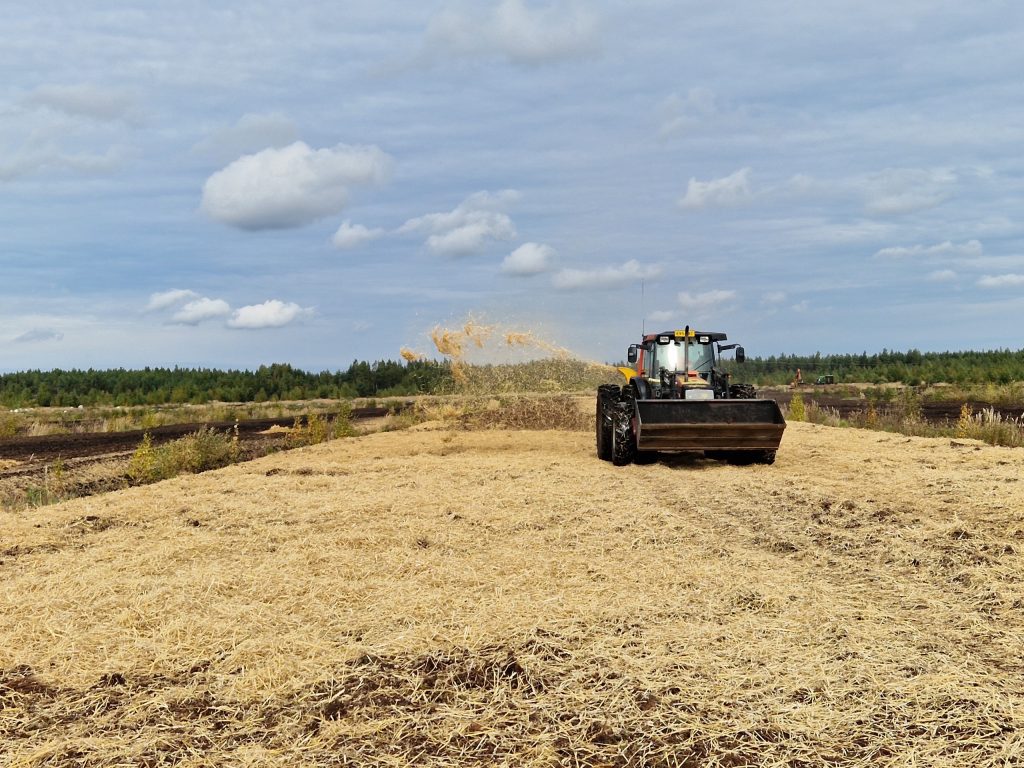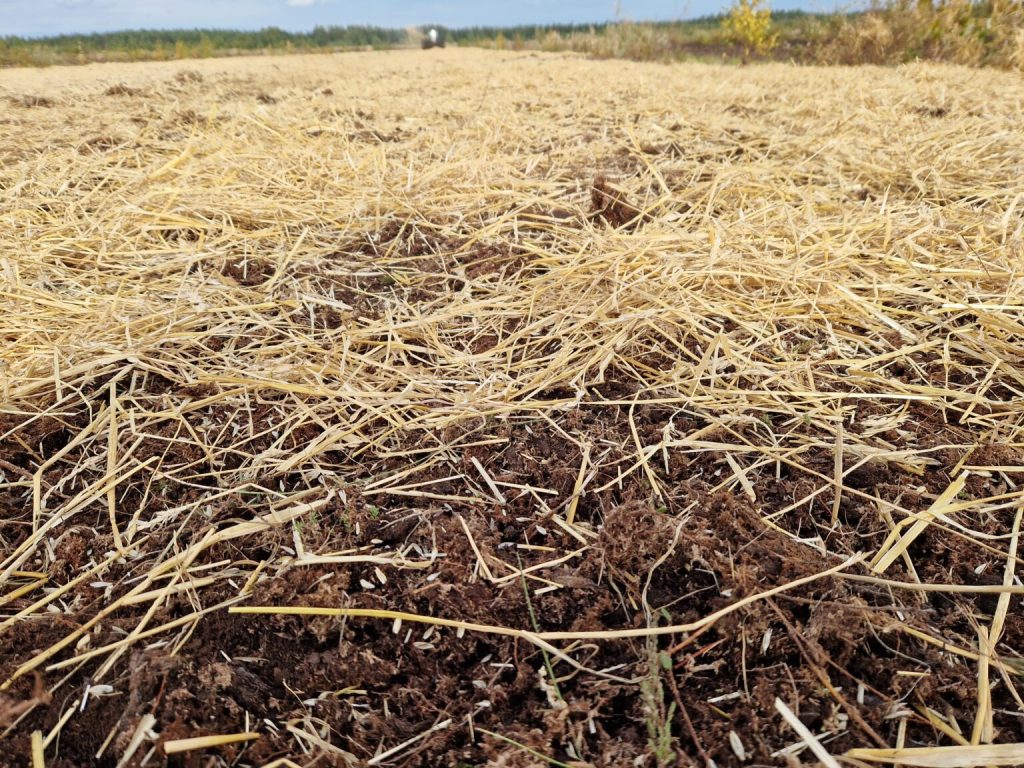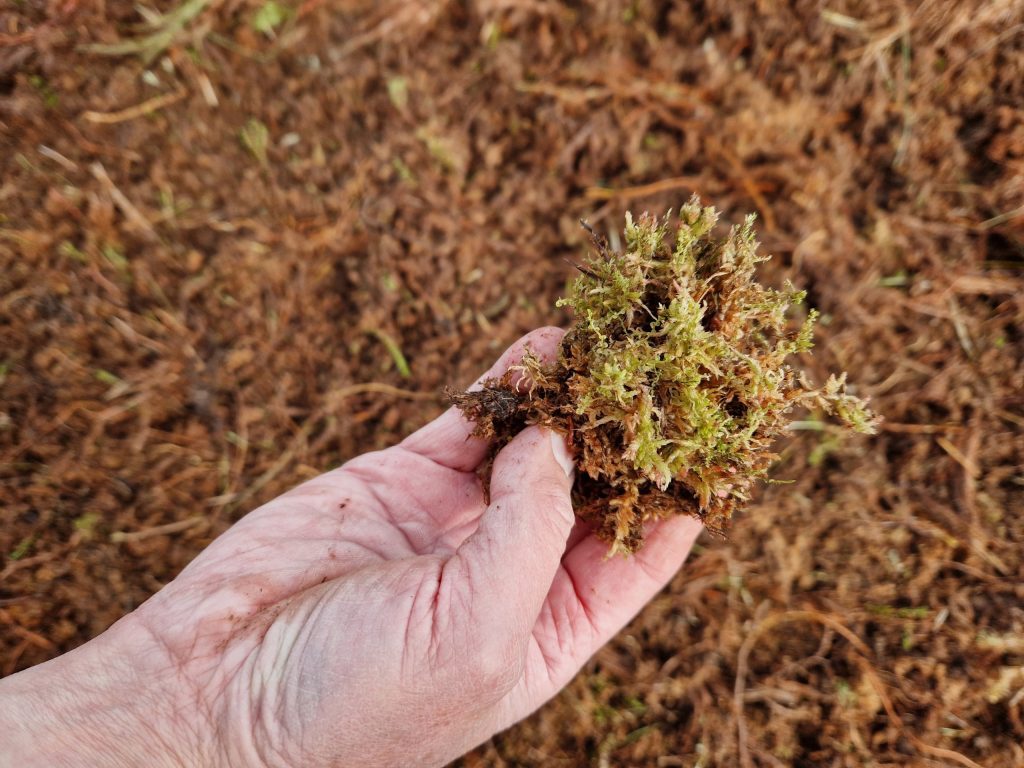Sphagnum farming experiment in former peat production area started – the first winter sowings ready
 For the first time in Finland, we (as part of the Neova group) are testing whether Sphagnum moss can be grown on a large scale by bringing in fresh sowing material into a former peat production area. The growing experiments of Sphagnum moss are carried out at the Haukineva site in Peräseinäjoki (Finland). A total of about eight hectares of Sphagnum moss was sown during this winter and last autumn. According to a preliminary estimate, it will be possible to collect Sphagnum moss from the area as growing media material in about ten years at the latest.
For the first time in Finland, we (as part of the Neova group) are testing whether Sphagnum moss can be grown on a large scale by bringing in fresh sowing material into a former peat production area. The growing experiments of Sphagnum moss are carried out at the Haukineva site in Peräseinäjoki (Finland). A total of about eight hectares of Sphagnum moss was sown during this winter and last autumn. According to a preliminary estimate, it will be possible to collect Sphagnum moss from the area as growing media material in about ten years at the latest.
In the past, the Neova group has been experimenting with the cultivation of Sphagnum moss on a small scale for research purposes. According to studies conducted in different countries, Sphagnum moss naturally begins to grow and multiply when it has favourable growing conditions. “Sphagnum moss is a rapidly renewable biomass that, as it grows, sequesters carbon and can be used as a growing media material in food production. The cultivation of Sphagnum moss is one of the potential successive land uses in former peat production areas,” says Ari Erkkilä, Senior Specialist at Neova, who is responsible for the farming experiment.
The cultivated crop must be protected, for example, with straw
The main characteristics of the area where Sphagnum moss can be grown are the flatness of the area, a suitable thick layer of remaining peat, the possibility of arranging optimal humidity conditions, as well as sowing material available nearby.
“The green, growing surface of Sphagnum moss at the edge of the sowing area was used as a “seed” to be sown. A layer about ten centimetres thick was collected. During the collection phase, Neova follows the principles of sustainable moss collection agreed in the industry. Before collecting the Sphagnum moss, the ELY Centre was notified of the collection and the matters related to the collection were reviewed,” Erkkilä says.
 Sphagnum moss is sown by spreading it in a thin layer over the cultivated area using a manure spreading trolley pulled by a tractor. After application, the cultivated area must be protected with straw, for example, in order to provide the Sphagnum moss with the best possible growing conditions and to start growing and multiplying. Straw reduces the scorching and drying caused by the sun in summer. It also protects the crop from the cold.
Sphagnum moss is sown by spreading it in a thin layer over the cultivated area using a manure spreading trolley pulled by a tractor. After application, the cultivated area must be protected with straw, for example, in order to provide the Sphagnum moss with the best possible growing conditions and to start growing and multiplying. Straw reduces the scorching and drying caused by the sun in summer. It also protects the crop from the cold.
For the growth and regeneration of Sphagnum moss, it is important to have a water level of a suitable height and to avoid drying out the crop. Therefore, adjustable pipe dams were installed in the ditches that were ready in the cultivation area. With their help, the water level in the breeding area can be adjusted to the desired height.
Sphagnum moss especially needs light and water to grow, but it cannot tolerate prolonged exposure to heat and drought. In the experimental area, different means of protection and cultivation, as well as crops without protection, will be tested in order to obtain information on which methods are the best way to establish best practices for Sphagnum cultivation. “Already after this winter, we will see how the changing weather conditions affect the sown Sphagnum moss and the protective layer. We also hope to receive information on whether the sowing time has an impact on the growth rate of the moss,” Erkkilä says.
Winter sowing of Sphagnum moss was completed last week. The goal of this winter sowing was to try sowing in a frosted field, which means that the bearing capacity of the field is sufficient even in softer areas. Large-scale cultivation requires the use of efficient equipment, but for peat moss growth, the soil must be sufficiently moist. Moving around the cultivation area with heavy machinery over thawed ground is challenging. Last autumn, sowing was carried out before the water level was raised in the cultivated area, when the cultivation area was still suitable for heavy machinery.
Sphagnum improves the properties of the growing media used for food production
As a result of population growth, urbanisation and the impoverishment of farmland, the demand for greenhouse substrates is expected to quadruple by 2050. One of the Neova Group’s most important product development areas is the new materials that complement horticultural peat in growing media.
 Sphagnum moss is often used as a raw material for growing media in combination with peat and other alloying materials. The properties of Sphagnum moss are especially useful in combination with new renewable substrate constituents. Even a small amount of Sphagnum moss in the growing media improves its water-retaining and growing properties.
Sphagnum moss is often used as a raw material for growing media in combination with peat and other alloying materials. The properties of Sphagnum moss are especially useful in combination with new renewable substrate constituents. Even a small amount of Sphagnum moss in the growing media improves its water-retaining and growing properties.
Kekkilä-BVB, part of the Neova Group, uses Sphagnum moss both in mixtures of consumer products and in growing media for professional farmers. In Finland, Kekkilä-BVB has been able to completely abandon the use of coconut fibre, which burdens the environment, with the help of Sphagnum moss.
Want to know more about Sphagnum?
Tom Huijs, Development Manager, Kekkilä-BVB tel. +31 6 55 83 46 55
This article is based on the original article as published on the Neova website.